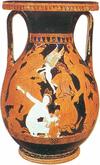- Marsyas Painter
-
flourished с 350–325 BC, GreeceGreek painter of the late Classical period, known for two containers, both dated 340–330 BC.Both are painted in the so-called Kerch style, named for the area north of the Black Sea where many such vessels were excavated. Characterized by slender, mannered forms, elaborate decoration, and polychrome effects, the Kerch style is thought to be the last major style of Attic red-figure pottery.
 "Peleus Taming Thetis," pelike by the Marsyas Painter, c. 340–330 BC; in ...By courtesy of the trustees of the British Museum
"Peleus Taming Thetis," pelike by the Marsyas Painter, c. 340–330 BC; in ...By courtesy of the trustees of the British Museum* * *
▪ Greek artistflourished c. 350–325 BCGreek (Greek pottery) painter of the late Classical period, known for a pelike (wine container), now in the British Museum, of “Peleus Taming Thetis,” and for a “Nuptial Lebes” (the bringing of gifts to the newly wed bride), now in the Hermitage at St. Petersburg. Both vases date from 340–330 BC, and both are in the so-called Kerch style, of which the Marsyas Painter is a key representative. (Kerch refers to the area north of the Black Sea where many of the vessels were excavated.) The Kerch style is recognized by slender, mannered forms; elaborate decoration; and polychrome effects, achieved through the heavy use of white paint and sometimes gilding. It is thought to be the last major style of Attic red-figure painting.* * *
Universalium. 2010.
